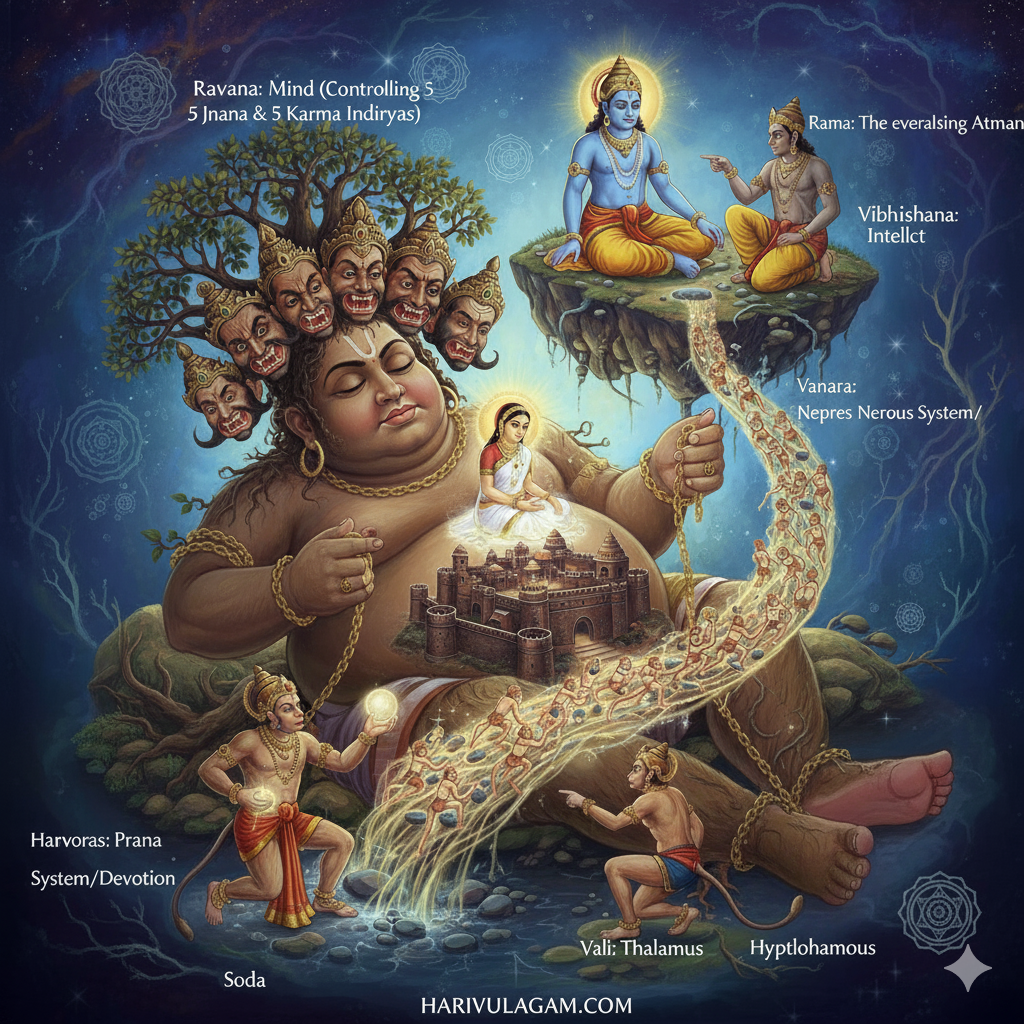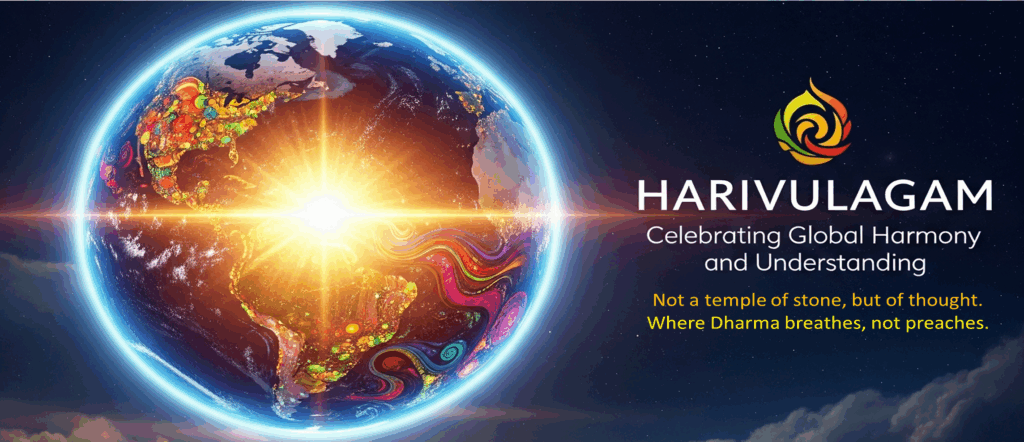Hari Om! A Special Feature for our Harivulagam Readers
Title: The Inner Ramayana: A Journey Through the Seven Kandas of the Self
For millennia, the sacred epic of Ramayana has graced the hearts and minds of seekers. We know it as the story of a righteous prince, a divine consort, a ten-headed demon, and a heroic quest. But what if the Ramayana is not just a story that happened once, long ago? What if it is the story happening within each of us, right now?

This interpretation invites you to look at the Ramayana as a sublime allegory for our own inner spiritual journey—the eternal struggle between the ego and the Self. Let us walk through the seven Kandas and map the epic events to the landscape of our own consciousness.
1. Bala Kanda: The Book of Inherent Unity
In the beginning, there is perfect harmony. Rama, the Supreme Self (Atman), eternal and pure, is united in a sacred marriage with Sita, the individual soul (Jiva). This is our own original state of being—a state of innocence and purity where the soul is perfectly attuned to the Self. The kingdom of Ayodhya is the sanctum of the heart, ruled by righteousness, and there is no hint of separation or sorrow. This Kanda represents the latent divinity and potential for perfection that resides within us all.
2. Ayodhya Kanda: The Book of Exile
The conflict begins. The seeds of ego and desire, sown by the mind, conspire to create separation. The Self (Rama) is exiled from its rightful kingdom (the conscious mind) and forced into the wilderness of worldly existence (samsara). This journey into the forest is the soul’s descent into a life governed by external circumstances and the challenges of the material world, separated from its inner source of peace.
3. Aranya Kanda: The Book of Abduction
In the forest of worldly life, the soul (Sita) is distracted by a golden deer—a powerful symbol for a glittering, transient worldly desire (Maya). In this moment of distraction, Ravana, the Ego-Mind, sees his chance.
With his ten heads representing the five senses of perception and five organs of action, the ego believes it is the all-powerful master of our being. He abducts the soul, carrying it away to his kingdom of Lanka, which is the deep, dark realm of our own subconscious mind and physical body. Here, the soul is held captive by the ego’s desires, fears, and attachments.
4. Kishkindha Kanda: The Book of Inner Alliance
The quest for reunion begins. The Self (Rama) cannot reclaim the soul alone; it must gain mastery over the faculties of its own being. This is the stage of Yoga and inner discipline.
- Rama first encounters the Vanaras, the monkey army, who represent our countless neurons and nerve impulses—the restless, chattering energy of our nervous system.
- To lead this army, he must resolve the conflict between Vali (the Thalamus), the brain’s powerful and tyrannical sensory gatekeeper that processes all raw input, and Sugriva (the Hypothalamus), which controls our primal emotions and survival drives.
- By overcoming the untamed power of Vali, the Self forms a divine alliance with a regulated and disciplined Sugriva. This signifies gaining conscious control over our sensory inputs and primal urges, directing the full force of our nervous system towards a single, noble purpose.
5. Sundara Kanda: The Book of the Leap of Faith
This beautiful Kanda is the story of Hanuman, who represents pure devotion (Bhakti) and life-force energy (Prana). Hanuman’s great leap across the ocean is a metaphor for a profound moment of meditative insight. It is the life-force, powered by unwavering faith, crossing the vast ocean of consciousness to find the captive soul (Sita) hidden deep within the subconscious fortress of Lanka. Hanuman does not rescue Sita, but he brings her a message of hope—the signet ring of Rama. This is the inner realization that the Self has not forgotten us and that liberation is possible.
6. Yuddha Kanda: The Book of Inner War
This is the great spiritual struggle (sadhana).
- Building the Bridge (Rama Setu): The Vanaras (neurons) work in unison to build a bridge to Lanka. This represents neuroplasticity—the creation of new, positive neural pathways and habits through consistent spiritual practice.
- The Battle: The Self (Rama) wages war against the forces of the ego.
- It must first defeat Kumbhakarna, the Body, rousing it from its deep state of tamasic inertia (sloth and gluttony).
- The crucial turning point comes when Vibhishana, the pure Intellect (Buddhi), makes the discerning choice to abandon his ego-brother Ravana and surrender completely to Rama. With the intellect as its guide, the Self knows exactly how to defeat the ego.
- Finally, Ravana is slain. The ego-mind with its ten sensory attachments is dissolved.
- The Agni Pariksha: The soul (Sita) must pass through fire to prove her purity. This is the final purification of the soul from all accumulated impressions and karmic traces (samskaras). With the ego gone, the purified Soul is joyfully reunited with the Supreme Self.
7. Uttara Kanda: The Book of Ultimate Liberation
The story doesn’t end with the happy reunion. It transcends it, revealing the highest states of freedom.
- Liberation in Life (Jivanmukti): Rama’s heartbreaking decision to banish Sita represents the ultimate state of detachment. The Self, now ruling the kingdom, must act according to universal Dharma, unattached to even its dearest individual soul’s emotional journey. It is the action of a being who is in the world, but not of it.
- Liberation from the Body (Videha Mukti): Finally, after a long and righteous reign, Rama walks into the Sarayu river. This is the Atman (the everlasting Self) consciously leaving the body built of five elements. It is not death, but the final, blissful merging of the manifested Self back into the formless, Absolute reality.
The Ramayana is a mirror. It shows us our own fragmentation and the path to our own wholeness. The choice is always ours: to live as a captive in Lanka, ruled by the ten-headed Ravana of our ego, or to undertake the glorious inner journey to allow the Rama within to reclaim our soul.
May we all find the devotion of Hanuman, the discernment of Vibhishana, and the courage of Rama to win the ultimate victory.
— From the team at Harivulagam.com


Leave a Reply